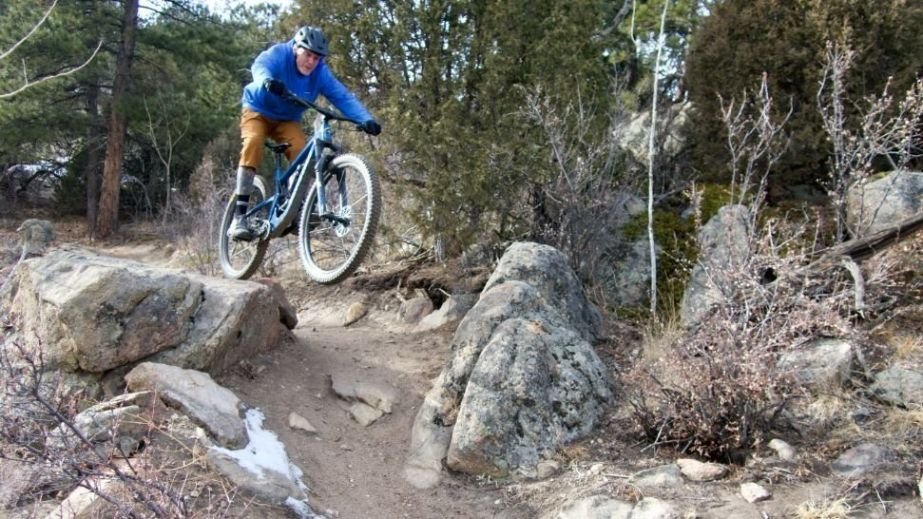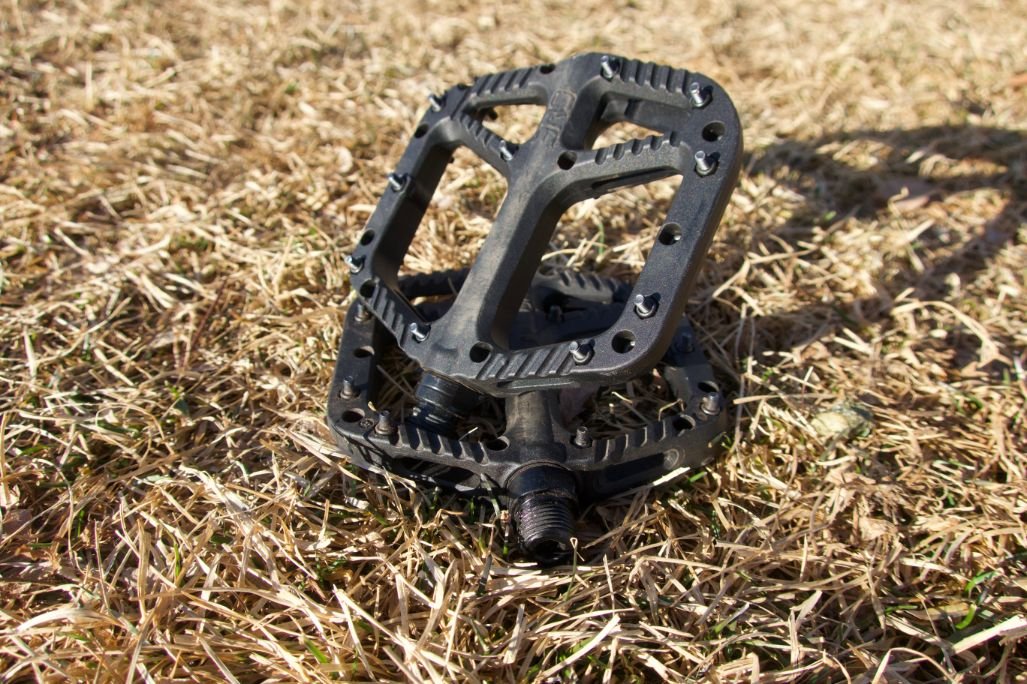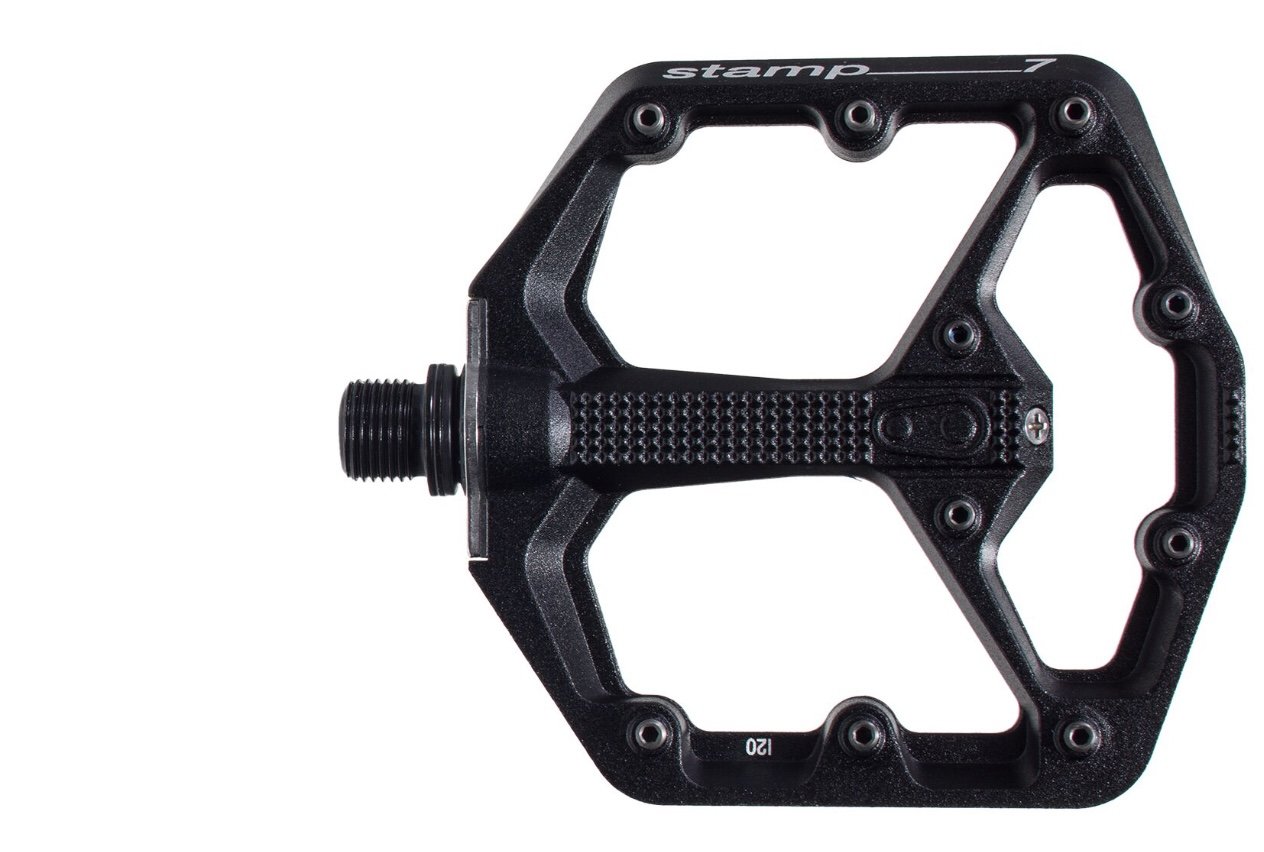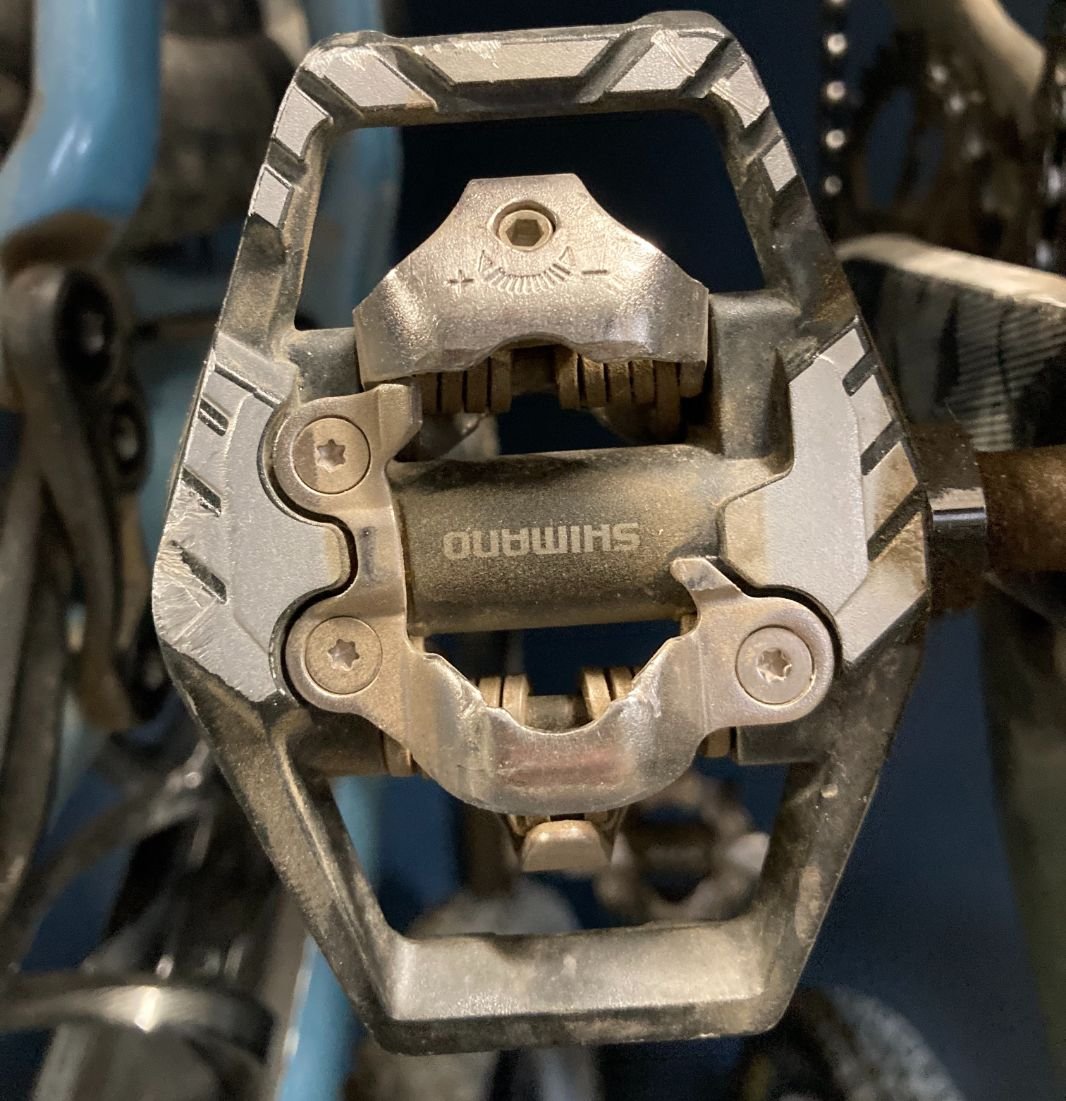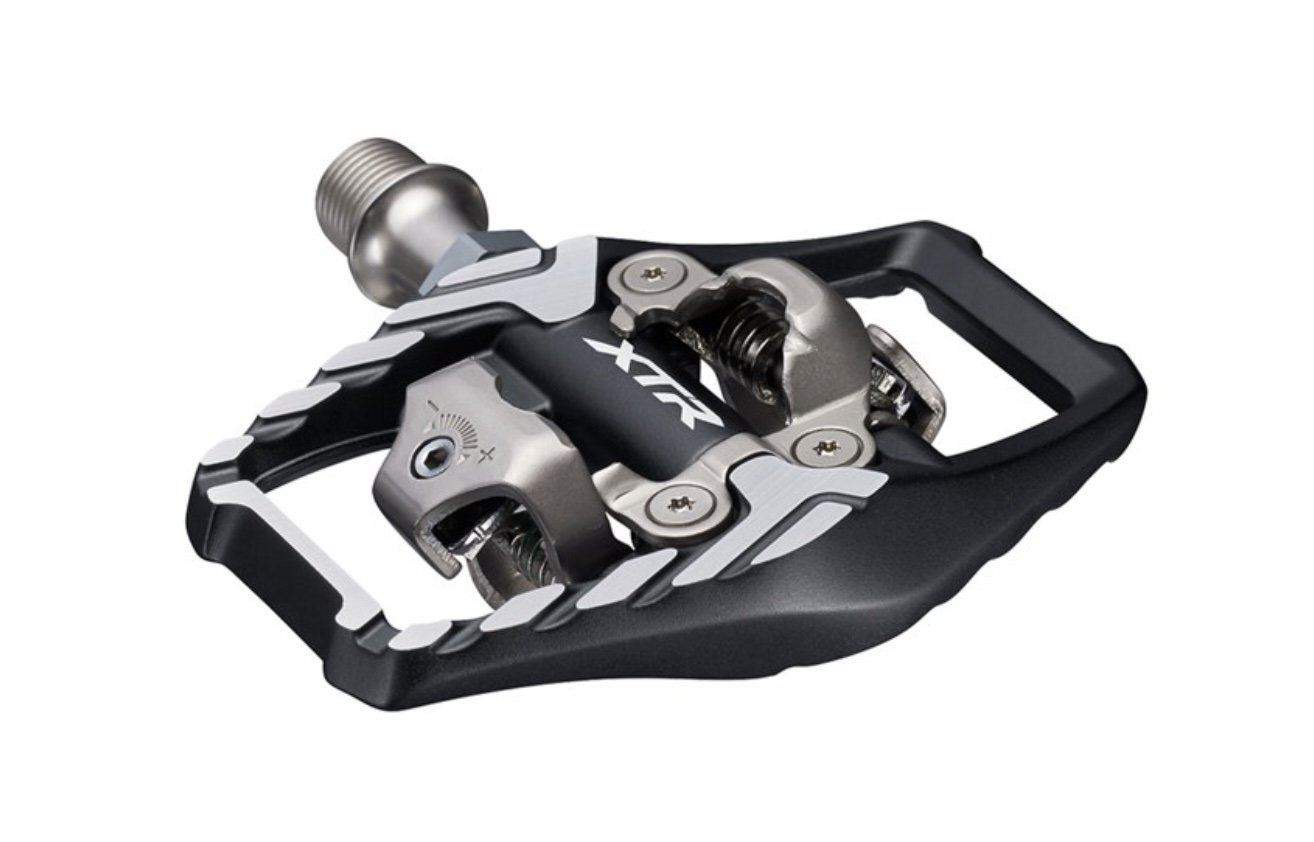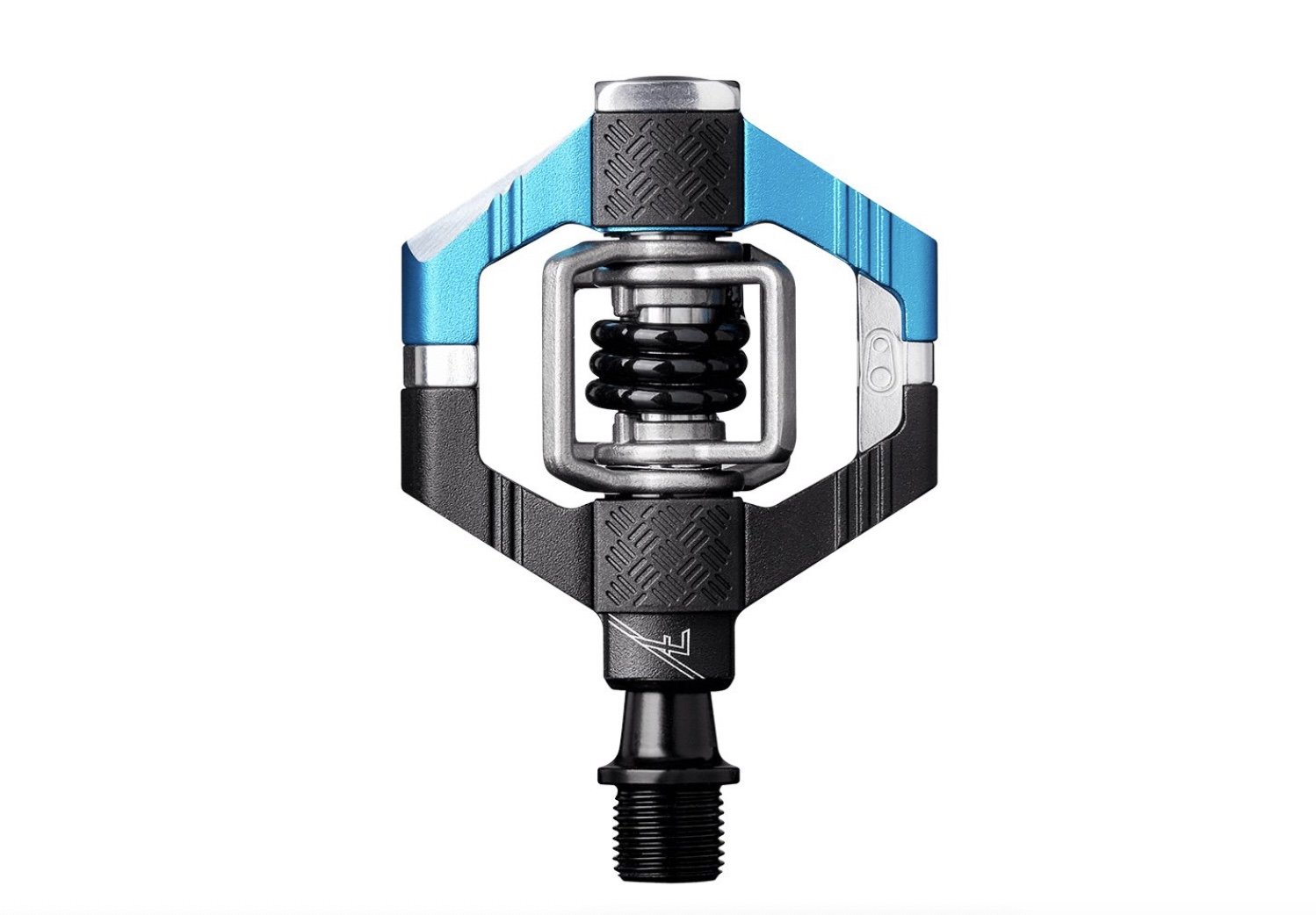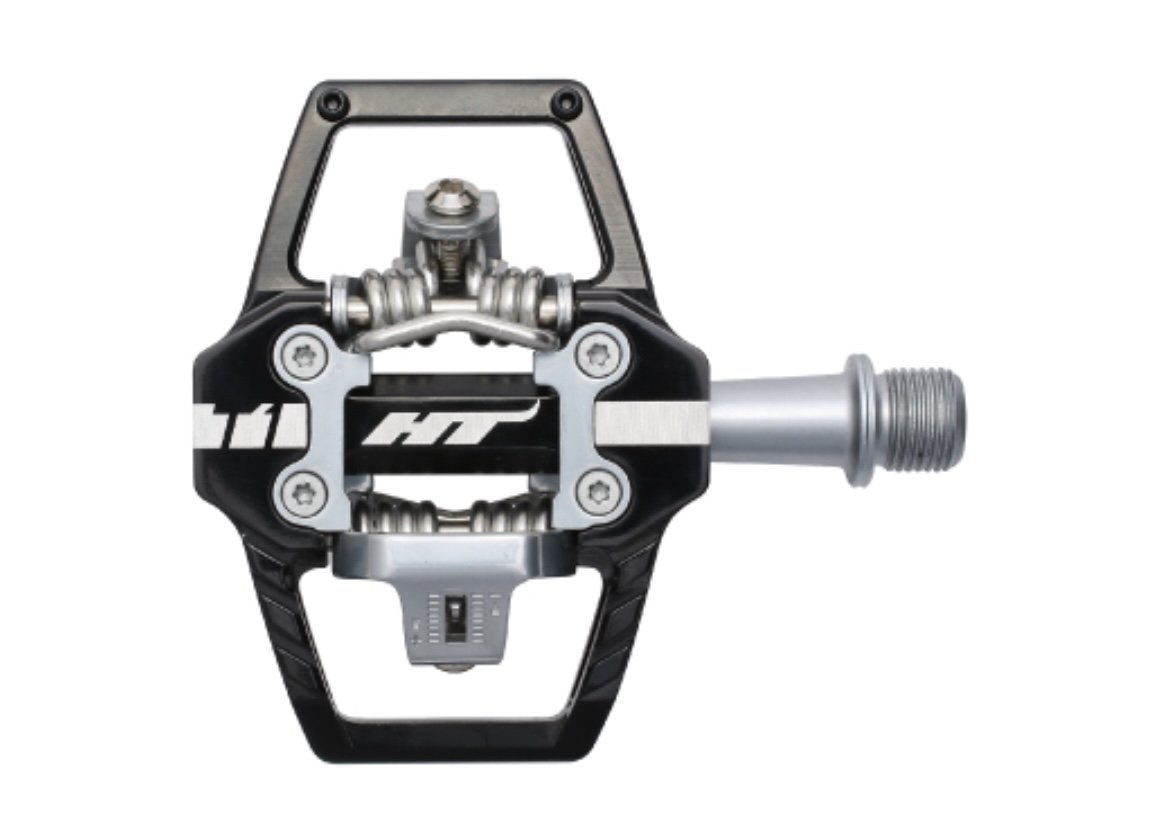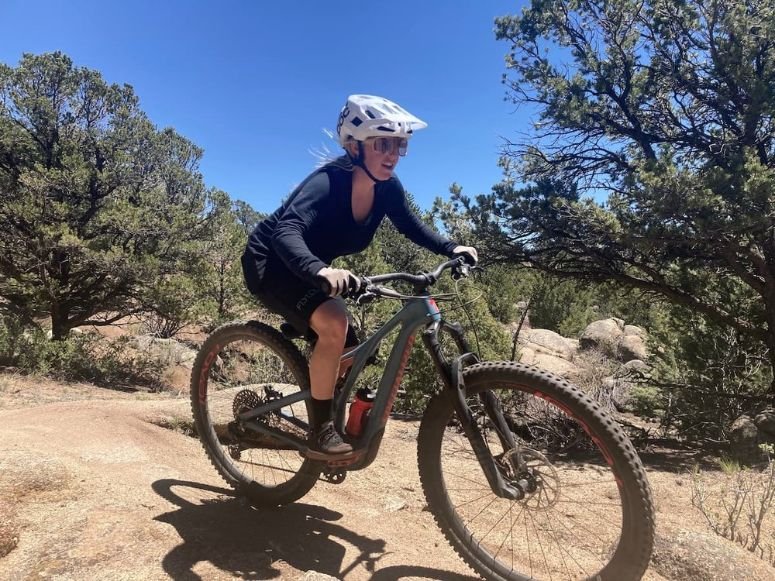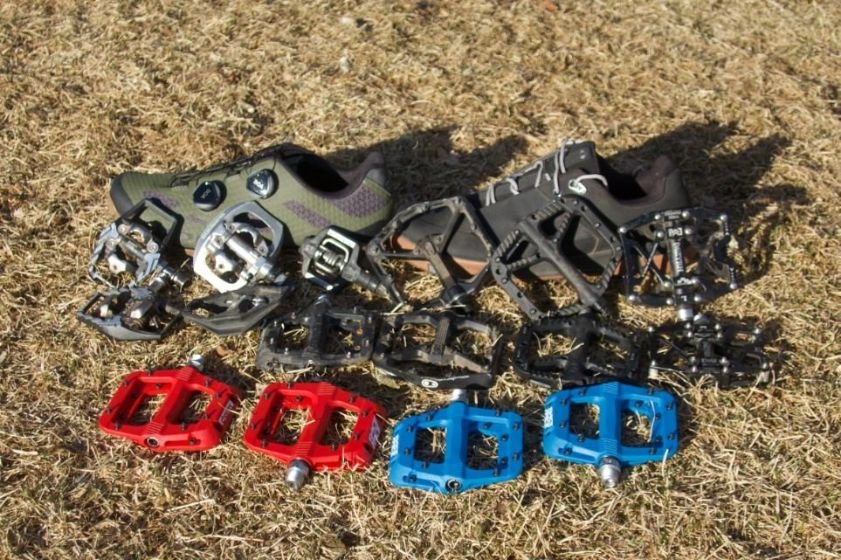Best Mountain Bike Pedals of 2024
The top mountain bike pedals for all situations: enduro, downhill, trail, cross country, and even gravel riders
Home > Gear Reviews > Bike
June 18th, 2024
The foot-to-pedal connection is where a bike’s engine — the rider — interfaces with its cranks (or its transmission and gears) to propel the bike forward. It’s also part of the mechanism for the mountain biker to steer or jump and bunny hop the bike.
The shoe-pedal interaction helps determine how much of that power is transferred to crank the pedals or move the bike in the direction the rider wants to move it.
We evaluated the best mountain bike pedals to determine which are the best to help riders go faster, further, and have more control on their bikes no matter what they’re taking on.
Thankfully, many great bike pedals don’t cost an arm and a leg, and you can get some great ones for as little as $21. After dropping $1k or more on a mountain bike, this price range is quite refreshing.
Your pedal and shoe work together, so be sure to check out our Best Mountain biking shoes guide.
We create reader-supported, objective gear reviews independently selected by our editors. This story may contain affiliate links, which help fund our website. When you click on the links to purchase gear, we may get a commission, without costing you an extra cent. Thank you for supporting our work and mission of outdoor coverage for every body! Learn more.
Comparison Table
| MTB PEDAL | OUR AWARD | CLIPLESS / FLAT / CAGE | WEIGHT (OZ) | MATERIAL | WARRANTY | BEST USES | MSRP* |
|---|---|---|---|---|---|---|---|
| One Up Components Composite Pedals | Best Overall Flats Read why |
Flat | 12.5 | Nylon composite | 1 year | All-arounder | $60 |
| Shimano XTR PD M9100 Race | Best Clipless Read why |
Clipless | 10.9 to 11.1 | aluminum/chromoly steel | 3 years | Race, ultralight, XC, CX, gravel | $180 |
| RockBros Nylon Fiber | Best Affordable Read why |
Clipless | 12.9 | Nylon | 1 month | For rough rides | $25 |
| Race Face Chester | Best Nylon Read why |
Clipless | 12.7 | Nylon composite | 2 years | All-arounder | $40 |
| Crank Brothers Stamp 7 | Best Metal Flats Read why |
Flat | 12.1 (small) 13.2 (large) | aluminum/chomoly steel | 2 years | Trail, Park, downhill, Enduro | $180 |
*Prices reflect MSRP. We note any discounts we see on our Deals page, which is updated daily.
See our most popular mountain bike guides in our Bike gear section:
The 7 best mountain bike pedals
Best Flat Pedal: OneUp Components Composite Pedals
Clipless/ Flat/ Cage: Flat
Weight: 12.5
Material: Nylon composite
Warranty: 1 year
What we liked: excellent grip, feels secure, convex design, value, versatility, easy to replace pins
What we didn’t like: not for riders who prefer aluminum, some durability issues
There are many great MTB pedals out there, but in the end, the Composite Pedals from OneUp Components came out on top, just edging out the Race Face Chester (see review below). No matter how tight the switchbacks or bumpy the drops, with excellent grip, the Composite Pedals from One Up felt secure underfoot. Our feet enjoyed the convex design. Retailing around $60, the Composites offer an incredible value, excellent grip, and a great platform for enduro riding, downhilling, and trail riding.
Compare Prices On The Oneup Components Composite Pedals
The OneUp Composite pedals have a convex design and more pins, giving them excellent grip and a secure feel underfoot.
Features
The 10 rear-loading pins per side protect the Allen heads, making them easy to replace. Unique among pedals we considered, they’re also available in six colors.
We loved ripping down the side of Maryland Mountain with these underfoot.
The Composite Pedals are slightly lighter, slightly bigger, and have more pins than the Race Face Chesters.
Who else likes it
Other bicycle media agree with our choice. The Outdoor Gear Lab gave them an Editors’ Choice award, observing: “We feel that OneUp knocked it out of the park with their Composite pedals. We liked them so much that they earned our Best Buy award for the dialed blend of grip and traction and weight paired with an outstanding price tag.”
They were also ranked highly by other magazines and sites such as Mountain Bike Review Forum and The Adventure Junkies, awarding them for their excellent grip. OneUp also offers these in an aluminum version, which is slightly heavier and more expensive.
Best Clipless Pedals: Shimano XTR PD-M9100 Race
Clipless/ Flat/ Cage: Clipless
Weight: 10.9 to 11.1
Material: aluminum/chromoly steel
Warranty: 3 years
What we liked: versatility, durability on cross country and trail
What we didn’t like: price, naming convention, can be difficult to find
Shimano is the biggest maker of clipless pedals for biking, and for a good reason. It makes some of the best pedals out there for both road biking and mountain biking. In fact, it has over 18 types of clipless pedals alone!
Of the Shimano pedal line-up, the XTR M9100 Race is our winner for the best clipless mountain bike pedals. We think the XTR PD-M9100 is the best clipless Shimano pedal because of its versatility. It's a tried and true lightweight pedal that's ideal for cross country and some trail riding.
View The Shimano Xtr Pd-M9100 Race
The Shimano XTR M9100 Race set-up on Treeline Review writer Stasia Stockwell’s bike.
Features
Treeline writer Stasia Stockwell tested these pedals for us extensively in Crested Butte and Buena Vista, Colorado.
She notes: “The XTRs are noticeably lighter [than other pedals] but also meant for a nice, stiff shoe. I like that the tension is easily adjustable.” She adds: “There’s just enough float to be comfortable, but I never had an issue with unintended releasing.”
These Shimano pedals are available with two spindle widths for those that prefer a narrower or wider stance when riding.
Who else likes it
The XTRs receive great reviews from BikePerfect calling it "beautifully smooth" and "stable." Gran Fondo Magazine said it "offers(s) a very solid feeling connection" and "guarantee a sporty performance. They said it takes some patience to get used to with less float. Still, they're touted as all-arounders and its that versatility that had us choosing the XTR as our top winner for clipless pedals.
Best budget MTB Pedals: RockBros Nylon Fiber
Clipless/ Flat/ Cage: Clipless
Weight: 12.9
Material: Nylon
Warranty: 1 month
What we liked: price, features available for the price
What we didn’t like: durability, weight
If you’re looking for an inexpensive bike pedal that still has the chops to handle serious mountain biking, the RockBros has you covered with its Nylon Fiber pedals. These plastic pedals only cost $25 or less, making them an excellent value considering they have features similar to other pedals in the category. For example, the RockBros have 10 rear-loading pins per side and sealed bearings.
Compare Prices On The Rockbros Nylon Fiber
Who else likes it
They have almost 4,500 reviews on Amazon and an average of 4.5 stars out of 5 stars. Outdoor Gear Lab, which rated them a Best Buy says: “These aren't the flashiest pedals with the latest technology, but they are perfectly functional and pleasantly effective.” It’s a few frills pedal that will get the job done but may not be as robust as other nylon pedals in the long run.
See our more mountain bike guides in our Bike gear section:
Best Nylon Flat pedals: Race Face Chester
Clipless/ Flat/ Cage: Clipless
Weight: 12.7
Material: Nylon composite
Warranty: 2 years
What we liked: value, durability, colors
What we didn’t like: not as grippy as other pedals we considered
We think the Best Nylon Flat pedal is the Race Face Chester. These flat pedals are affordable and durable because they are made of nylon rather than more expensive metals. That material and good pin placement create a lightweight yet robust bike pedal that can take a beating and keep on going. Nylon also means the Chesters are available in 10 colors, the most of any pedals we considered. The Race Face Chester is a much-praised nylon mountain bike pedal that has lived up to its hype and has faced years of abuse on our bike.
Compare Prices On The Race Face Chester
The Race Face Chesters are MTB pedals with 8 rear-loading traction pins per side and a convex design.
Design
The Race Face Chester has a lot of similarities to Overall Best Flat Pedals, the OneUp Composites, which are the same price. The big difference between the two is the Race Face Chester has a convex design while the One Up Composite has a concave design.
Some riders prefer a concave design, which allows riders to adjust their feet more easily. A convex design cups the foot more, locking it in place. The OneUp has a more secure, locked-in feel. But the Race Face allows for more foot placement options. That's why we think the Race Face is great for those who like to use multiple positions while riding.
Grip
With just 8 rear-loading traction pins per side, the Race Face doesn’t offer quite the grip of the OneUps, but we’ve never had a problem slipping off the pedals. We think it's worth a little less grip to have more foot placement options with the Chesters.
Who else likes it
That's one reason the Chester pedals are favorites of many other reviewers as well. Outdoor Gear Lab named them a Best Buy. They are among The Adventure Junkies’ best pedals and GearJunkie named them best overall. We agree with GearJunkie’s comment that “this could be the only pedal you’ll ever need. Better yet, you can actually afford it.”
Best Metal Flat pedals: Crankbrothers Stamp 7
Clipless/ Flat/ Cage: Flat
Weight: 12.1 oz (small), 13.2 oz (large)
Material: aluminum/chomoly steel
Warranty: 2 years
What we liked: weight, surprising durability of the thin material, comes in smaller sizes
What we didn’t like: still not as durable as other materials
In one iteration or another, Crankbrothers’ Stamp pedals make most reviewers’ top MTB pedals list. We agree. We had a chance to mash on the Stamp 7 Large pedals, which offer the widest and longest platform we tested.
The Stamp 7 Large was one of the thinnest pedals we tested. Despite pedal strikes and crashing into boulders on trails in Colorado, the durable aluminum pedal held up well. While we used it with various shoes, we also used it with Crankbrothers’ Stamp shoes which have a tread pattern that matches the pin pattern on the pedals. (See our Best MTB shoes guide for a full review of those shoes)
View The Crankbrothers Stamp 7
Unlike most flat pedals, the Crankbrothers Stamp 7 has front loading pins of various lengths to aid in the concave design.
Design
Unlike most other flat pedals we awarded, the Stamps have front-loading pins of varying lengths, with shorter traction pins towards the middle of the foot to aid in the concave design. We did notice some damage to the Allen heads of pins after riding but could still get them out with pliers.
Sizing
We also love that the Stamp pedals come in a smaller size for people with smaller feet. This means that more people can get outside and use top notch pedals, which hasn't always been the case.
Who else likes it
Named a Top Pick by Outdoor Gear Lab, GearJunkie, and Bikeperfect, this is great for downhillers and riders that want more pedal underfoot.
BikePerfect notes: "Crankbrothers has been making high-quality platform pedals for a long time now, and its current Stamp series of pedals caters to a range of riders and price points. The pro-level Stamp 7 is an excellent balance of price and performance.”
Options
It’s also available in several versions, including a less expensive composite version and one with a titanium spindle, which is more expensive.
Best Clipless Platform pedals: Shimano XT M8120
Clipless/ Flat/ Cage: Clipless
Weight: 15.5
Material: Chrome-moly steel
Warranty: 2 years
What we liked: support underfoot for technical or rough terrain, value for the price, easy entry and exit
What we didn’t like: expensive
If you’re looking for a clipless pedal with more support underfoot for cross-country and all-mountain adventures, the Shimano XT M8120 is the pedal to check out. Among similar Shimano pedals, the XT M8120 is an excellent option because it offers a lot of value.
We also tested the XTR M9120, which is a more expensive model (review below). Comparing the two, they both offer relatively similar ease of entry and exit and performance on the trail.
They’re about 40 grams heavier per pair than the Shimano XTR M9120 (review below) and have a similar grooved platform. The SPD pedal mechanism's cage is larger and wider than its predecessor and offers a little extra support while riding technical or rough terrain.
Compare Prices On The Shimano XT M8120
The Shimano XTR M8120 is the best clipless platform MTB pedal because it offers a lot of value and durability. Here, they are shown on Treeline Review writer Stasia Stockwell’s bike. Photo by Stasia Stockwell.
Durabilty
In the end, the XT M8120 proved more durable in the end, making it a better value, especially considering the price difference.
Who else likes it
Others who named the XT M8120 among their top choices were Outdoor Gear Lab, BikeRumor, and BikeRadar.
BikeRadar contends: “The Shimano XT M8120 pedals are true fit-and-forget performers, requiring little to no maintenance and offering great resistance against tough, muddy conditions thanks to a large platform and easy setup.”
The bottom line
We agree that the Shimano XTR M8120 offers a lot of value and durability and are an excellent choice for a clipless platform pedal for folks riding rougher trails.
Lightest Clipless Pedals: Crankbrothers Eggbeater 11
Clipless/ Flat/ Cage: Clipless
Weight: 6.3 oz
Material: stainless steel
Warranty: 5 years
What we liked: weight, warranty
What we didn’t like: expensive, learning curve
If you’re counting the grams and want the lightest mountain bike pedal available, you will likely start looking at the long-running Eggbeaters line of pedals. While there are many Eggbeater options to choose from, the Crank Brothers Eggbeater Titanium 11s are the lightest of the light, at 179 grams per pair.
Compare Prices On The Crankbrothers Eggbeater
Eggbeaters 11
Eggbeaters 3
Design
The Eggbeaters are all engagement mechanisms, allowing for entry from four sides. They’re very minimal in size and underfoot. However, the Eggbeater 11s are weight rated for people who are 200 pounds and less. They are also expensive at $449.99.
If you're looking for an alternative without a weight limit and that is more affordable, the Eggbeater 3’s are ¼ the price and are still incredibly light at 280 grams. Plus, they don’t have a maximum rider weight like the Eggbeater 11s.
Who else likes it
The Eggbeater 3’s are a top pick of Outdoor Gear Lab, which says: “If you ride or race in the mud and have experience with clipless pedals, we think you could appreciate these. Due to their small body and lack of adjustability, we wouldn't likely recommend them as anyone's first pair of clipless pedals.”
Other pedals we considered:
There are many excellent mountain bike pedals out there. Shimano alone has 18 pedals designed for mountain biking, CrankBrothers has over 30 models, Time has 12 pedals, and Look has 11. Those are just some major manufacturers. In all, there are likely hundreds of mountain bike pedals out there. We focussed on testing the best-rated pedals, and these were among those we considered that didn’t quite make the grade in our testing and evaluations.
Clipless/ Flat/ Cage: Clipless
Weight: 15.4 oz
Material: Chrome-moly steel
Warranty: 2 years
In testing, the Shimano XTR M9120 was an excellent MTB pedal. It rode very smooth on the bearings, but we noticed on our review unit that the spindle seal on the M9120 came loose on both pedals after just a few rides. Other testers noticed the same issue with the seal. For that reason, we were a little reluctant to name it a top winner for a high-end pedal that offers minimal weight savings over the M8120 Shimano pedal.
VIEW THE SHIMANO XTR M9120
Clipless/ Flat/ Cage: Clipless
Weight: 11.3
Material: Aluminum
Warranty: 5 years
We like the engagement mechanism on the Crank Brothers Candy 7. It is a highly reviewed pedal, among both media and customers. But we received our test units a little too late in the season to give them adequate testing. We hope to spend more time with them in 2022 for a possible reevaluation.
COMPARE PRICES ON THE CRANKBROTHERS CANDY 7
HT Components T1
Clipless/ Flat/ Cage: Clipless
Weight: 13.1 oz
Material: Aluminum
Warranty: 1 year
The HT Components T1 is a highly ranked competitor to the Shimano XT M8120 was an Editor’s Choice at Outdoor Gear Lab and a top pick from some other testers, but we didn’t have a chance to review it ourselves.
VIEW THE HT COMPONENTS T1
Mountain Bike Pedal Basics
Mountain bike pedals fall into two main categories, clipless and flats. Clipless pedals are designed to (ironically) clip onto a cleat on a specially designed cycling shoe to keep the rider connected to the pedal and give some extra power on the upstroke.
Flat mountain bike pedals have a platform usually studded with pins designed to provide grip. They interact with the gummy soles of flat mountain bike shoes, which give ample grip no matter how you place the shoe on the pedal.
Clipless vs. Flats
Clipless pedals are generally much smaller than flat pedals for mountain biking. The larger surface area of a flat pedal makes it efficient for transferring power to the chain and makes it easy to provide a stable interface between the shoe and pedal. In a clipless system, locking the shoe into the pedal and the sole's stiffness provides stability and power transfer.
Clipless vs. Flats: Which is best for mountain biking?
There is a lot of debate over which is best for mountain biking; we think both have a place for different uses. We think clipless pedals are great for most cross country, gravel riders, and even some trail riders. Some folks, including Treeline writer Stasia Stockwell, like clipless pedals for enduro and downhill riding, but we think some of the demands of those trails and types of riding are better suited for flat pedals.
Pros of clipless
Clipless pedals make it easier to get more power on the upstroke of your pedaling and make moves like bunnyhops and whipping the bike's tail around. You can do all this with flats, too. You just have to know how to bunnyhop and whip the bike around with more skill.
Pros of flats
In very technical sections like rock gardens, tight switchbacks, and technical downhill sections, a mountain biker needs to be able to get their feet off the pedals as quickly as possible to dab a foot or even throw the bike away from them. Here, flats have a clear advantage over being locked into the pedal in a clipless pedal.
Treeline Review writer Stasia Stockwell riding in Colorado. Stasia was one of the testers for MTB pedals for this story, specifically considering pedals for people with smaller feet. Photo courtesy Stasia Stockwell.
Best pedals for types of riding
With mountain bike shoes, we chose favorites for certain types of riding. Pedals are a little different since it’s really up to riders’ preferences for what they want. In light of that, we chose winners for different categories: Best Flat Pedals and Best Clipless Pedals; Best Bargain; Best Nylon Flat Pedals; Best Metal Flat Pedals; Best Clipless Platform Pedals; and Lightest Clipless.
Pedals for gravel and cross-country
For gravel grinders and cross-country riders who often want to go as light as possible and may opt for a very lightweight shoe with a stiff plank of a sole, a lightweight clipless pedal with little to no platform will work great.
Pedals for clipless trail, enduro, or downhill
For those who want to go clipless on the trail, enduro riding, or even downhilling, we recommend clipless pedals with a bit of platform. For instance, CrankBrothers Eggbeater pedals are great for easy clipping in since that’s all they are — clips. But without a larger platform to support your foot while jumping and making sharp switchbacks, you may feel less support underfoot than you want.
Pedals for those who prefer flats
We recommend flat pedals primarily for trail, enduro, and downhill riding. These often have more technical sections where a rider may need to plant a foot in a split second to avoid crashing into a boulder or sliding off a steep, narrow section of trail.
There are a ton out of flats out there! We’ve found some great pedals that are pretty inexpensive, like the RockBros Platform Pedal, for as little as $21! A cable and housing can cost more! It’s one part on a bike that is likely upwards of $1,000 that you don’t have to spend a lot of money on to get a quality product.
Some flat pedals are so inexpensive because they use inexpensive but durable nylon rather than more expensive metals. That creates a lightweight yet robust bike pedal that can take a beating and keep on going. That’s thanks to strong nylon and composite materials and good pin placement.
Hybrid Pedals
One type of bike pedal we didn’t look into much for mountain biking is the hybrid pedal. These usually have a flat-style side with pins for grip as well as a clipless side. Going back and forth between the two sides while riding technical or rough terrain is sometimes frustrating, though we love that approach for the city and casual bikes.
We tested numerous mountain bike pedals side-by-side with different riders taking them on trails of varying technical terrain. These are just some of the mountain bike pedals we tested for this article.
How we Researched & Tested
We followed a well-developed trail network of testing and research by pedaling through expert reviews from over 10 sites and magazines as sources for expert material. We coupled those with verified customer reviews of mountain biking shoes and consulted with our numerous mountain biking buddies.
Two of our in-house experts tested shoes throughout Colorado. They took them on trails and downhill courses along the Front Range and in and around Crested Butte. After compiling our in-house testing with expert and customer reviews, we made our picks for the top mountain biking shoes in numerous categories.
We did a meta-analysis of some of our favorite sources like Switchback Travel, The Outdoor Gear Lab, and The Adventure Junkies. Still, we also consulted numerous bicycling-specific and mountain bike-specific sources like Mountain Bike Rider, Bike Perfect, and Singletracks. This range gave us a comprehensive source of experts reviews to look at and to compare and contrast.
We tested the shoes on some of our old and new favorite trail networks like Floyd Hill and Winter Park’s Trestle Bike Park, Deer Valley Resort in Utah, Buena Vista, Breckenridge, and more doing a combo of enduro and downhill riding primarily.
The difference in size between different pedals is evident. There is a flat pedal on the bottom and two types of clipless pedals on the top.
Buying Advice
Regardless of whether you’re riding clipless or flat pedals, all-mountain bike pedals must do a few things well. First and foremost, they must provide a solid connection between the shoe and the pedal, which is accomplished in different ways. Both MTB pedals must shed mud well, rotate smoothly without spinning, and handle being bashed relentlessly on rocks, trees, and other obstacles.
Beyond that, things get different. Clipless pedals may or may not have a platform and may or may not have traction pins. On flat pedals, both these factors are essential. So from here, we’ll explain the most important features for each.
Two types of clipless pedals: the Crankbrothers’ clipless system on the left and Shimano’s on the right.
Clipless pedals
The defining feature of a clipless pedal is the clipping or locking mechanism and how it interacts with the cleat on the shoe. We tested clipless pedals for how easy it is to clip in, how much float (lateral movement) they have while clipped in, how easy or hard it is to unclip, and whether they’re adjustable. We also considered clipless pedals with some platform and those without a platform.
Entry
Entry of a good clipless pedal should be easy. Stomp down on it, and you’re in; that’s what you want. It always feels reassuring to hear that click when you mash down on the bike pedal.
Exit
Exit should also be relatively easy. However, you don’t want it to be too easy because you could unclip when you don’t want to. Exit is controlled both by the tension — on adjustable pedals — and the cleat itself. Some pedals and cleats allow for more float, meaning you can move your foot around a little before the mechanism unclips and sets your shoe-free.
Float And Adjustability
The majority of clipless pedals and cleats are Shimano SPD-compatible and can offer up to about 6° float before releasing. (SPD stands for Shimano Pedaling Dynamics and is pronounced like the potato.)
Some SPD pedals offer less float before releasing, which makes it easier to unclip. On many Shimano-style pedals, like the Shimano Deore XT M8120, you can adjust the release tension tighter or looser depending on your needs. For example, more novice riders will generally prefer a looser setting so that it’s easier to unclip.
Crank Brother pedals offer cleats with different release angles and float levels. Their pedals, like the Crank Brothers Eggbeater, aren’t tension adjustable. But you can add traction pads or shims to change the thickness of the pedal underfoot and the feel of how the pedal interacts with your shoes.
When you’re buying new cleats, it’s essential to ensure they’re compatible with your pedals and have the float or lack thereof that you want.
Some clipless pedals, like the Crank Brothers Egg Beater, are minimalist, while others, like the Shimano XTR PD-M9120 Pedals, have a platform. Some platform pedals even have pins. We didn’t evaluate any of those for this test as we feel the pins can make unclipping a little more complicated.
However, platforms are nice in many instances, as they provide a little more solidarity underfoot, especially when using a shoe with a little more flexibility like the Giro Chamber II. You won't need as much platform if you’re riding with a shoe like the Giro Empire VR 90 because the outsole is incredibly stiff.
Other advantages of smaller platforms — or not having a platform on clipless pedals — are that they reduce the likelihood of pedal strikes on rocks and other obstacles. Generally, they also shed mud better than platforms.
Two models of flat pedals: the Crankbrothers Stamp and RaceFace Chesters. Over time, flat pedals will see some wear in the pins. Here, the Allen heads of the pins on the Crankbrothers Stamp pedal (top) are damaged, and some will have to be removed with pliers. Damage is also evident to pins on the well-loved RaceFace Chesters on the bottom right, compared to a new pair on the left.
Flat pedals
With flat pedals, it’s all about the platform: that, and the pins.
Platform
The platform of the pedal should not be any wider than your shoe. A pedal like the CrankBrothers Stamp Large might be too big and wide for someone with a smaller foot; hence, they also offer a smaller-sized version of the pedal.
Length
Length-wise, it’s important to have as much surface area of the pedal under the shoe's sole as possible. But the longer the pedal, the more likely you are to strike it against obstacles. Most flat pedals we tested were about 4 1/2” long. That gives you ample space underfoot for multiple foot positions and quick, secure foot placement while mashing hard on the pedals.
Pins
The pins are also crucial on flat pedals. They grip into the sticky rubber on mountain bike shoe soles to keep your foot in place. Pins provide grip even if the pedal body is slick with water or mud. We recommend removable pins and prefer rear-loading pins like those on OneUp’s Composite pedals. You can still use an Allen wrench to replace them, even if they’re bent or otherwise bashed after multiple seasons. The Allen heads on the top of pins, like the CrankBrothers Stamp pedals, can get smashed, and you’ll need pliers to get them out.
Protip: You can buy replacement pins from the pedal manufacturer or a bike shop like Jenson USA. But if you’ve got a hardware store nearby, you might be able to find the pins in bulk for less money. Depending on the grip you want, you could also choose shorter or longer pins than what came with the pedals.
Protip 2: Be careful when riding with pinned pedals. One of our buddies required stitches — twice! — after slicing his calf on the traction pins during a couple of falls. He now wears kiddie shinguards over the back of his leg to prevent it from happening again.
Shape: Concave Vs Convex
The shape of many flat pedals isn’t flat, some are slightly concave, and others are convex. Concave pedals are skinnier close to the center of the pedal, better cupping your shoe. Convex pedals are thickest at the middle of the pedal and taper towards the ends. This shape makes it easier for riders to find multiple foot positions while riding.
The leading edge of many modern flat mountain bike pedals is chamfered–angled rather than having a square edge–to reduce the likelihood of a straight-on pedal strike, so they’re more likely to bounce off rather than stick on an object when they hit it.
Materials
Some of the best flat pedals are made of nylon composites. They’re light, inexpensive, shock-absorbing, and can handle repeated bashing. We still have–and can use–the first pair of Race Face Chester pedals that were on our 2018 Sant Cruz Higher LT after countless rides, pedal strikes with rocks, roots, and steel.
Other flat pedals are generally made of aluminum. A popular example is One Up Components Aluminum pedal. They’re a little more durable and generally a little heavier than nylon. Aluminum pedals are less likely to crack if there is a direct strike. However, some riders worry that metal pedals are more likely to stick on rocks than nylon.
Durability and the Environment
As stated, even the nylon pedals are durable, lasting more than 4 years of tough riding, and we haven’t had to repack or replace the bearings in any of our pedals, thankfully. Not that it’s a difficult task with most of our top winners as most component manufacturers sell bearing kits for their pedals.
Concerning the environment, we haven’t come across any durable mountain bike pedals that claim to be made of recycled aluminum or nylon. But with the ability to refresh bearings and pins, pedals should last you many years, and the primary reason you should buy new pedals is to upgrade or change from clipless to flats or vice versa.
How to Choose the Best Mountain Bike Pedals for You
When choosing the best mountain bike pedals, the first thing to consider is what type of riding you plan to do the most. Do you plan on epic cross-country rides or bikepacking trips, or will you primarily be riding the slopes in the summer? See our section on Best Pedals for Types of MTB Riding for some ideas.
If you’re primarily riding trails and enduro-style or doing a lot of downhill riding, we recommend one of our picks for flat pedals. If you’re doing a lot of cross-country or gravel riding, we recommend one of the winners for best clipless mountain bike pedals. If you’re just getting into mountain biking and aren’t sure, we recommend flat pedals since they’re easier to learn on.
How much do you want to spend on mountain bike pedals?
If you want flat pedals, you can get a quality pair like the excellent Race Face Chesters for $60. If that’s too much, RockBros Platform Bearing Wide Pedals are only $20.99. They often cost a little more if you’re opting for clipless mountain bike pedals, but Shimano’s ME700 are only $65. Crankbrothers’ high-end offerings like the 179-gram Eggbeater 11 fetch a far higher price, at $449.99.
FAQ
Can I use road pedals on a mountain bike?
There is no hard and fast rule that you cannot use road pedals on a mountain bike or vice versa, but each type of pedal is designed intentionally for a specific purpose. All of the pedals featured in this review are designed specifically for mountain biking, and there are a few key differences from road pedals, especially with clipless style pedals. Clipless mountain bike pedals are designed, generally, to be more durable and easy to get in and out of.
Many road bike pedals are made with plastic to save weight, while mountain bike pedals are often made with metal (clipless ones in particular) because durability is crucial when you’re riding trails. And the biggest difference is that mountain bike clipless pedals systems are designed in such a way that the rider is able to walk in the shoes with the cleats on them if necessary. Clipless road pedal systems—the cleats specifically—are not meant to be walked on. Not only will this greatly impact the durability, it will also likely junk up the cleats with dirt and other debris, making it tough to clip in and out of the pedals.
While there are plenty of lightweight MTB pedals out there, road pedals tend to be both lighter and less durable because the weight savings is more important and durability not as much of a concern since you’re not going off the paved road. Additionally, many popular road bike pedals have a clip on only one side. This isn't much of an issue when you’re riding smooth roads. But when you’re riding on rough trails, clipping in can be trickier and you want to up your chances with a double-sided clip pedal.
Flat pedals are less particular, and most road cyclists opt for clipless pedals rather than flats for efficient pedaling power (unlike mountain bikers, who are often split on their preference between clips and flats).
Moral of the story: If you’re looking for mountain bike pedals, especially clipless ones,
Can I use clipless pedals with regular shoes?
Clipless pedals are designed as a system and they’re intended to work with specific cleats and, often, specific types of shoes. In general, and especially if the pedal is an egg-beater style, flat shoes do not work well with clipless pedals. It will be uncomfortable at best and at worst your shoe won’t grip the pedal at all. If you’re riding with flat pedals, find a good pair of flat shoes with grippy rubber on the soles for the best performance. If you choose to go clipless, get clipless shoes with stiff soles that are designed to work with the specific pedal system you choose (for example, if you have SPD pedals you need to ensure that your shoes are compatible with SPD cleats).
How do I choose the right pedal size for my foot?
When it comes to flat pedals, the size of the pedal matters a lot for the stability and grip you get when riding. Larger platforms offer both more grip and more stability, and therefore better performance. 9/16” is the standard size for mountain bike pedals, and that’s what you should look for no matter your shoe size.
How often should I replace my mountain biking pedals?
Mountain bike pedals are made to be durable and should ideally last you many seasons of riding, but this depends a lot on how hard you ride and how well you take care of your pedals. Most flat pedals made for mountain bikes have small rivets or spikes that help you grip on the pedal. Better pedals will allow for these to be replaced when necessary to extend the life of the pedal, while lower-end pedals will not have the option to replace these. That means if your rivets are not replaceable, then you’ll want to replace your flat pedals when those wear out.
Mountain bike clipless pedals are made to be more durable than road bike pedals, but that doesn’t mean they last forever. You will likely need to replace the cleats on your shoes before the whole pedal, as these often wear out quicker. If the pedal no longer spins on the crank, or if the clip mechanism has failed for some reason, then it’s probably time to replace the whole pedal system.
Care and maintenance
Mountain bike pedals don’t need a lot of maintenance, thankfully. You’ll need to clean them off after riding, adjust clipless pedals to make them easier or harder to release, and replace broken or bent pins. The only other maintenance they could need is replacing their sealed bearings.
Adjusting clipless pedals
Some clipless pedals, like those from Shimano, have adjustable tension screws. When first learning to ride clipless, we recommend loosening the tension to make it easier to unclip; after getting used to them, tighten the tension to your needs. You may find that they become a little looser over time, and you can adjust them to make them tighter. However, it’s important to ensure that the cleats aren’t too worn, which can make unwanted unclipping happen.
Some clipless pedals, like Crankbrothers’, don’t have tension adjustments. However, they have traction pads and shoe shields that help modify the cleat's feel and engagement underfoot.
Replacing pins
For flat pedals, most maintenance will be replacing pins that have smashed and bent or broken against rocks. You’ll usually use an Allen key, but occasionally, you may have to remove stubborn pins with pliers.
Bearings
Over time even sealed bearings can get damaged as water or mud corrode them or sand and dirt get in them. Thankfully you can buy sealed bearing replacement kits to refresh your pedals. However, depending on the price of the kit, you may want to consider replacing the entire pedal.
why you should use a Pedal Washer
If you plan to ride on multiple pedals or use the same pedals on multiple bikes, use a pedal washer before installing them. Pedals are designed to tighten as you ride them, and absent a pedal washer, they can get pretty stuck on crank arms.
Author Chris Meehan riding his bike in Colorado.
About The Author/Why You Should Trust Us
As an outdoors writer covering adventure and gear, I have written multiple pieces about mountain biking, and I have a long history with the sport. I have also contributed multiple guides to Treeline Review, Backpacker, and other outdoor publications/organizations.
My experience with mountain biking stretches back to the Appalachians in the late 1980s when Specialized, Trek, Gary Fisher, and Cannondale were among the first companies to mass-produce mountain bikes — my first ‘mountain bike’ was a 10-speed Huffy Scout, which I got around ‘87. It was around the time that the first clipless pedals for a road bike were allowed in competitions and shortly after were introduced for mountain biking. Before that, bikers used toe clips for more power and connection to their pedals. I think I had my first pair of clipless pedals around ’92.
These days, I spend most of my time mountain biking, backpacking, hiking, climbing, and crisscrossing Colorado and the Rocky Mountain region. I enjoy using my knowledge of gear and skills to learn about new equipment and how it will benefit me (yes, I’m selfish) and Treeline’s readers.
I have authored multiple outdoor guidebooks. My most recent Falcon Guide is Colorado’s Best Front Range Adventures: The Greatest Hiking, Climbing, Paddling and More From Denver to Colorado Springs and Fort Collins. In it, I cover the best hiking, biking, climbing, and rafting in the region.
I’m also the author of Falcon Guide’s Climbing Colorado's Fourteeners: From the Easiest Hikes to the Most Challenging Climbs and edited Justin Lichter’s excellent guide to thru-hiking titled Trail Tested: A Thru-Hiker's Guide To Ultralight Hiking And Backpacking. This experience has helped me become a first-rate gearhead and product tester.
I have 20-plus years of exploring, mountain biking, hiking, backpacking, climbing, guiding, and playing in the wild. I worked with National Geographic and their mapping division in developing their Colorado 14ers Map Pack Bundle. I’ve written about hiking and climbing for Elevation Outdoors, including stories about Colorado 14ers and outdoor apps to boost adventures.
I’ve written about countless outdoor companies, outdoor sports, and tested gear with publications including CompanyWeek, Outdoor USA Magazine (print), Elevation Outdoors, 5280, and more.
At Treeline Review, we strive to offer unbiased reviews to help you find the best product for the price. Treeline Review doesn’t accept native advertising or paid reviews. I am not sponsored by any companies, nor are any of my family members sponsored by or employees of, or ambassadors of any of the companies in this review.
You can see all of Chris’s stories on his author page.

